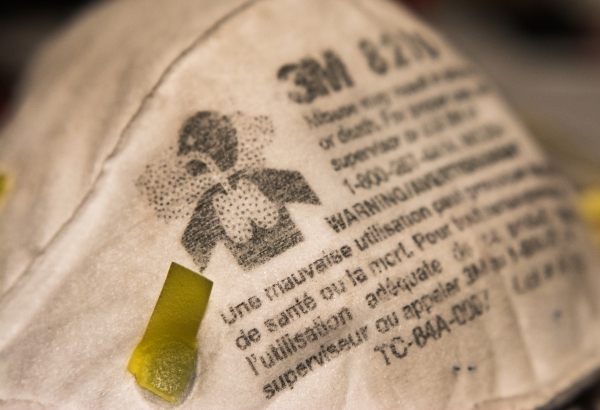WEST TOWNSHEND — Finally, thanks to Covid, everyone knows about the work of respiratory therapists. We're now recognized as the profession that manages folks connected to mechanical ventilation. Nurses and doctors rely on respiratory therapists' knowledge and experience to help patients return to breathing on their own.
Now that I am retired, the best use of my 25 years of experience in respiratory therapy work is to publicly share my knowledge and point of view.
Let's start with masks.
There are two types: surgical and N95. The most common and affordable are surgical masks, worn by people on the street. N95 masks are more rigid and form fitting with a pliable metal bracket across the bridge of the nose to create a tight seal. They are meant for short-term use only, in the room of a patient with a contagious disease, such as active tuberculosis or active covid.
During my respiratory training, it was drummed into students that surgical masks do not prevent the spread of germs; they simply prevent large particles - say, from a sneeze - from entering a sterile surgical field. Only N95 masks block microbes and are touted to protect against 95 percent of contagious germs.
I was trained to achieve a secure N95 fit. Annual training included a spritz of scented aerosol in your face. If you could smell it with the mask snugly in place, it was not tight enough.
After fit testing, subsequent N95 use required the user's memory of the feeling of proper tightness. Subsequently, it's the professional's responsibility to know when to wear a surgical mask and when to wear an N95 mask.
So you can understand my reluctance to wear a Covid-mandated surgical mask. Why aren't people on the street using N95 masks? The answers: They are too expensive, are in short supply, and are not designed for continual use.
* * *
Frankly, as I review the research from the Centers for Disease Control and Prevention (CDC), I am conflicted by wording that states that surgical masks are effective because they block the Coronavirus, which is encapsulated in water droplets.
Air generally contains moisture. If the moisture is trapped on the inside of the mask along with the encapsulated “bug,” why then is there no condensation running down one's face? Does a mask block moist air from both entering and exiting? Why, then, is it possible for masked folks to develop Covid? Could there be other reasons to explain Covid's ability to sneak past one's immune system?
The CDC also claims that surgical masks leave plenty of room for carbon dioxide to escape on exhalation - no need to worry about CO2 toxicity, manifested as headaches or sleepiness. One study utilized a tiny sample size -12 people. The conclusion: more study is required.
In the meantime, the CDC is reporting “no problem.”
Is this acceptable science?
In a YouTube video, Gregory Schmidt M.D., an intensive care specialist at the University of Iowa, claims there is absolutely no problem clearing carbon dioxide from a face mask. He demonstrates this using one young adult, standing still, using a pulse oximeter to measure blood oxygen and a capnograph to measure exhaled CO2.
Does a study of one person qualify as acceptable, reportable science? Is the viewer supposed to believe this without a question, because a doctor says so?
What are the long-term effects of constant mask use - for example, at work? What about a typical American, who might be obese, have hypertension or diabetes, or be highly stressed? These conditions themselves are toxic.
Add to this the fact that most folks ignore breathing altogether. While the normal respiratory rate is 12 to 20 breaths per minute, my observations indicate that the majority of people breathe more frequently, often as much as 30 times per minute, which is one breathing cycle - outbreath and inbreath - every two seconds.
I question that there is actually enough time for the CO2 to “wash out” of the mask before the next unfocused, shallow inhale. What's most likely happening is that some of the old air, full of CO2, is being re-breathed, over and over again.
And why are children, starting at the age of 2, required to wear masks? These youngsters have even-higher normal breathing rates. Two-year-old children typically breathe 25 to 35 times per minute.
This raises the same concerns about the ability to clear carbon dioxide from the mask. Added to this physiological concern are psychological ramifications - kids who refuse to don a mask or kids who are afraid of people wearing masks.
If you're a masked 4-year-old, your face has been covered for half of your lifetime, and you've known only people who are masked, including your essential caregivers, mom and dad. How is this impacting the growth, development, and understanding of these new world citizens?
* * *
What is the real issue? America is sick.
Our health status ranks number 10 among the financially richest nations, yet our national health care budget exceeds that of the average nation.
In 2019 - just one year - the CDC says that 659,041 folks died of heart disease, 599,041 of cancer, 173,040 of accidents, 156,979 of chronic lung disease, and 150,005 from stroke. Since Covid's onset in 2019 - over two years ago -723,8800 U.S. citizens have died.
Which conditions are more pernicious?
How can you keep your immune system healthy and prevent disease? Start with a commitment. Go for a walk every day. Decrease or eliminate the use of drugs, alcohol, and other mind-body numbing substances. Fall in love with a glass of water. Take control of your breathing. Reinvent yourself.
You are the only one who can create and maintain your own health. Then share your story with a friend.
